[email protected] ransomware is the virus that uses the RSA encryption algorithm and demands the victim to contact criminals via the email
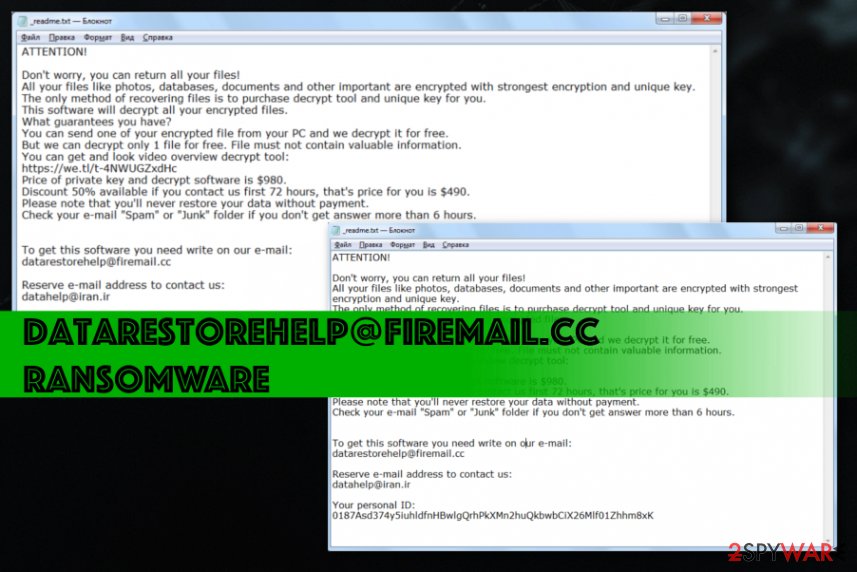 [email protected] ransomware is the threat that encodes common files to have a reason for the ransom demand delivered in the _readme.txt immediately after the encryption process. The note from cryptovirus developers includes a typical text used by DJVU ransomware versions for years now and a particular victims’ ID, contact information. The [email protected] email is the feature that many victims indicate online mostly. It is believed that these last two versions, including the same email in their contact information section, are more active than other ones released recently.
[email protected] ransomware is the threat that encodes common files to have a reason for the ransom demand delivered in the _readme.txt immediately after the encryption process. The note from cryptovirus developers includes a typical text used by DJVU ransomware versions for years now and a particular victims’ ID, contact information. The [email protected] email is the feature that many victims indicate online mostly. It is believed that these last two versions, including the same email in their contact information section, are more active than other ones released recently.
If you find that your machine got affected by the [email protected] ransomware virus, it resembles Zobm ransomware and Rote virus infections and indicates that your computer needs some serious malware cleaning if you want to get your files back. Unfortunately, solutions don’t include decryption for a while because the last two tools capable of file recovery cannot help with versions released after August 25th. First Djvu virus variants were decryptable with the help of STOPDecrypter after that, Emsisoft released a tool that can decrypt files affected by the 148 versions and some other files encoded using offline keys. However, for others, the best solution remains anti-malware tools and data backups.
| Name | [email protected] ransomware |
|---|---|
| Type of the malware | Cryptovirus/ File locker |
| Family | STOP/ Djvu ransomware |
| Recent versions of appendixes | .rote, .zobm, .kodg, .mbed, .grod, .peet, .lokf, .toec, .meka, etc. |
| Ransom note | _readme.txt is the file that delivers all the needed information for the victim. The ransom demanding message is written in this text file, and the user gets encouraged to pay for the alleged decryption key, contact developers via email |
| Contact emails | [email protected] and [email protected] |
| Distribution | Pirated files, software cracks, licensed tool version keys, infected documents attached to spam emails, other data injected with malicious script distributed on corrupted websites, hacked versions of legitimate services. The main vectors for delivering the ransomware payload used by this family are infected files[1] |
| Elimination | There is no debate whether you need [email protected] ransomware removal or not, but the best solution for the infection is the anti-malware program that can detect and eliminate this virus fully |
| System recovery | Encryption affects common types of data, but system folders, directories, and other system preferences get corrupted without your notice. To tackle that virus damage, you should run Reimage Reimage Cleaner or another system tool on the machine, so files get repaired without the risk |
[email protected] ransomware is the malware that focuses on blackmailing victims because developers are focused on gaining money from users. The attack starts with choosing files for encryption, then the particular algorithm is employed for encoding – the original code of the image, video, audio file or document gets altered and makes the data unopenable.[2]
Encryption is possible due to particular keys that get used by the virus. However, the more recent versions in the same family, including [email protected] ransomware, started to rely on more difficult and unique methods when the connection to the C&C server is included when IDs get generated. This is why decryption is no longer possible for variants released after August of 2019 when these major changes got made.
The file that contains all the contact information and the particular victims’ ID is named _readme.txt and gets delivered on the desktop immediately after file-locking. The message remains the same for all the versions and offers the discount as an options for victims. You shouldn’t believe a word in the following note:
ATTENTION!
Don’t worry, you can return all your files!
All your files like photos, databases, documents and other important are encrypted with strongest encryption and unique key.
The only method of recovering files is to purchase decrypt tool and unique key for you.
This software will decrypt all your encrypted files.
What guarantees you have?
You can send one of your encrypted file from your PC and we decrypt it for free.
But we can decrypt only 1 file for free. File must not contain valuable information.
You can get and look video overview decrypt tool:
https://we.tl/t-4NWUGZxdHc
Price of private key and decrypt software is $980.
Discount 50% available if you contact us first 72 hours, that’s price for you is $490.
Please note that you’ll never restore your data without payment.
Check your e-mail “Spam” or “Junk” folder if you don’t get answer more than 6 hours.To get this software you need write on our e-mail:
[email protected]Reserve e-mail address to contact us:
[email protected]
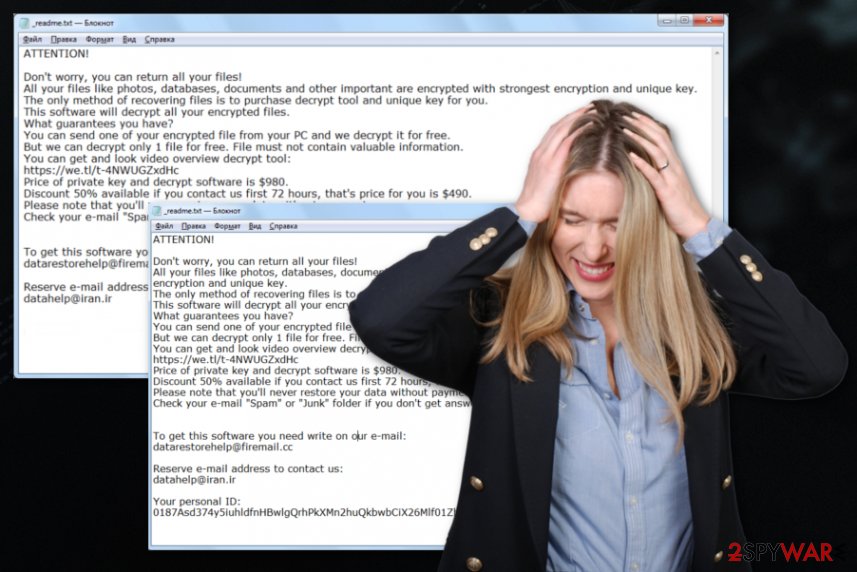
[email protected] ransomware is the cryptovirus developed recently but most of the features remain unchanged for three years or more. The ransom note placed in the _readme.txt file is one of them. Since decryption is not an option, you should remove [email protected] ransomware and focus on file recovery after that. Keeping the threat on your machine gives nothing and can give more time for the additional scripts to get loaded. In some cases, AZORult trojan gets released on the already infected machine to collect data and personal or sensitive details from the computer.
You may store encrypted files on external devices with the hope that the decryption tool for the virus will get released later on. However, many researchers speculate that [email protected] ransomware remains persistent until law enforcements get to catch hackers behind it or their databases get leaked, encryption process changes again.
Experts[3] note that you need to go straight to [email protected] ransomware removal after receiving the ransom message because the biggest damage is done, and there are only a few minutes when you still avoid further infections and permanent corruption to the system.
When you get rid of the malware using the proper anti-malware application, you can then focus on recovering files encrypted by the [email protected] ransomware. That might be difficult or barely possible because of the encryption methods and malware persistent.
Additionally, [email protected] ransomware runs other processes in the background and alters parts of the system to keep the machine infected for longer. Shadow Volume Copies get deleted, security functions disabled and Windows Registry entries deleted or changed. When the inexperienced user tries to fix these issues manually permanent damage can be done, so rely on Reimage Reimage Cleaner or a different PC repair tool and try to fix the damage this way. 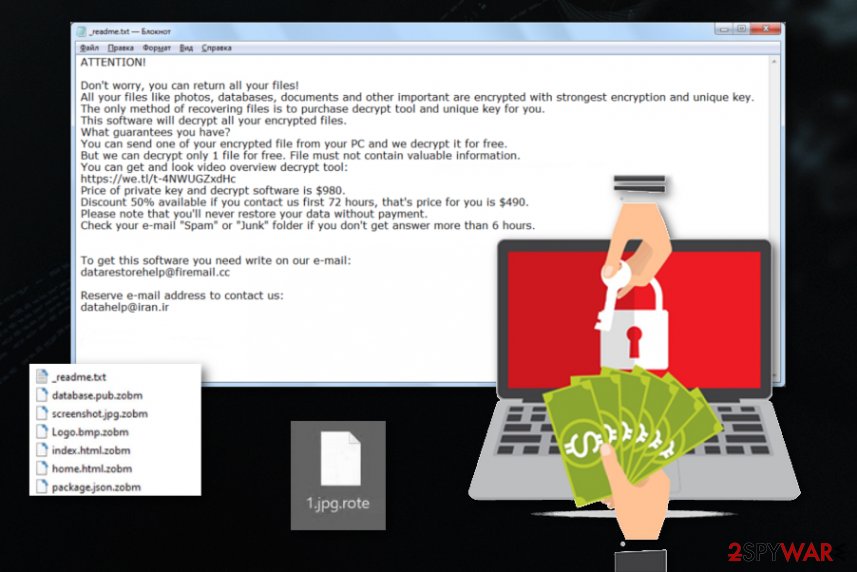
[email protected] is the email used by the more recent versions in Djvu family appending encoded files using .zomb and .rote extensions.
Cracked software and game cheats lead to legal and PC security issues
The most common technique used by malware providers and developers is relying on gullible people and deceptive methods. Hacked website, copies of legitimate services, and provider domains spread fileless malware, trojans, cryptocurrency miners, and even the notorious ransomware.
Each team of criminals, virus family has different methods, and go-to techniques, so do this one. Pirated software, video game cheatcodes, software cracks, and other content that can be downloaded from torrent services, networks, and illegal sites come pre-packed with malicious files.
Spam emails often do too, so paying attention to such details can cost you important files or even money. When an infected file ends up on the machine, you as a user only need to trigger the malicious script execution that happens with a few clicks of the mouse: when you install the crack or download the file filled with macros. Keep anti-malware tools that can check such downloads beforehand.
[email protected] ransomware elimination and file recovery options
Since [email protected] ransomware virus is one of 187 variants in the notorious cryptovirus family, you should react as soon as possible and don’t even consider paying a penny for those criminals. Fulfilling their wishes gives nothing for you in the long run because the alleged decryption key most likely is not going to reach your device.
As for [email protected] ransomware removal, you need to employ professional anti-malware tool and try to eliminate any malware-related files or applications to ensure that data can be recovered on the safe system. This is best achieved with tools like SpyHunter 5Combo Cleaner, or Malwarebytes that keep the machine protected from various intruders.
As for your encrypted files and particular damage that the virus left behind, you need to remove [email protected] ransomware itself completely and then try to get the system back to a normal state using a system application like Reimage Reimage Cleaner that may find and fix corrupted system files for you. File recovery after encryption takes a bit more effort, some options are listed below.
Remove [email protected] using Safe Mode with Networking
Reboot the system in Safe Mode with Networking and then run the AV tool to remove [email protected] ransomware completely
- Windows 7 / Vista / XP
- Click Start → Shutdown → Restart → OK.
- When your computer becomes active, start pressing F8 multiple times until you see the Advanced Boot Options window.
- Select Safe Mode with Networking from the list
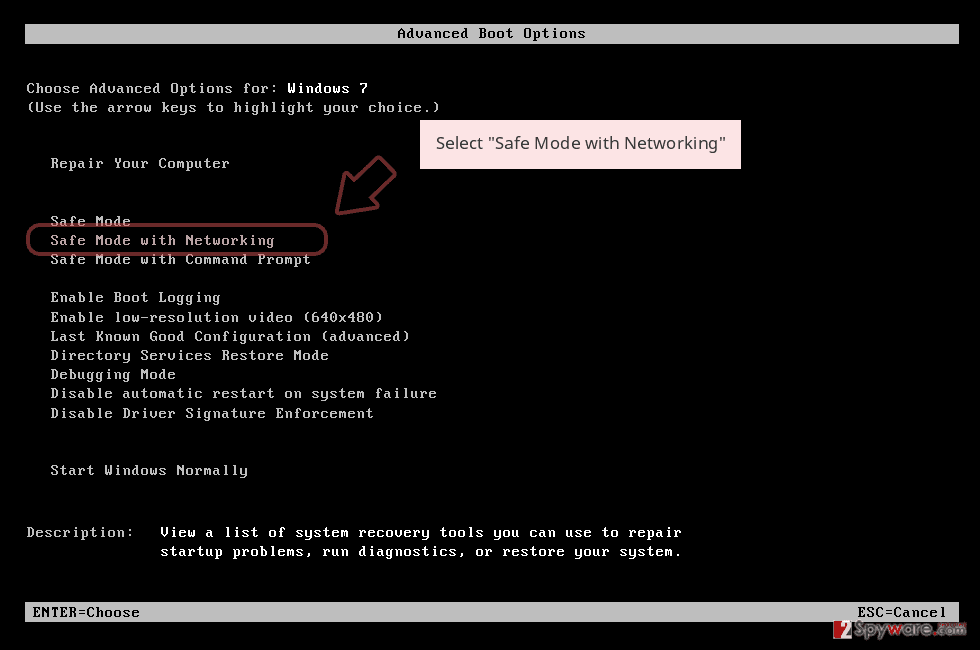
Windows 10 / Windows 8
- Press the Power button at the Windows login screen. Now press and hold Shift, which is on your keyboard, and click Restart..
- Now select Troubleshoot → Advanced options → Startup Settings and finally press Restart.
- Once your computer becomes active, select Enable Safe Mode with Networking in Startup Settings window.
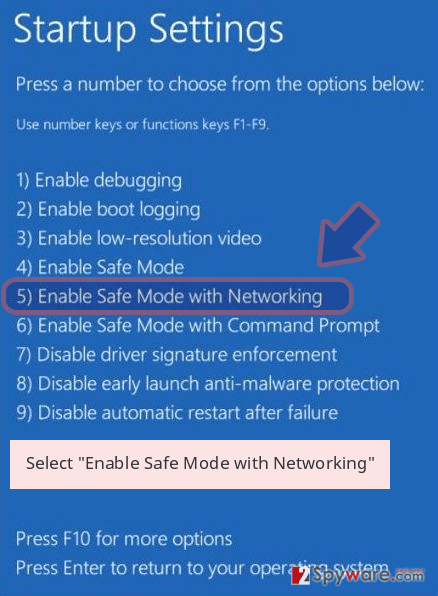
-
Log in to your infected account and start the browser. Download Reimage Reimage Cleaner or other legitimate anti-spyware program. Update it before a full system scan and remove malicious files that belong to your ransomware and complete [email protected] removal.
If your ransomware is blocking Safe Mode with Networking, try further method.
Remove [email protected] using System Restore
System Restore feature is the method that can be useful for virus termination because you recover the system in a previous state
Bonus: Recover your data
Guide which is presented above is supposed to help you remove [email protected] from your computer. To recover your encrypted files, we recommend using a detailed guide prepared by 2-spyware.com security experts.
If your files are encrypted by [email protected], you can use several methods to restore them:
Data Recovery Pro is the program that can help with [email protected] ransomware affected files
People encounter various incidents when their data requires repairing, so Data Recovery Pro can restore encrypted or accidentally deleted files
- Download Data Recovery Pro;
- Follow the steps of Data Recovery Setup and install the program on your computer;
- Launch it and scan your computer for files encrypted by [email protected] ransomware;
- Restore them.
Windows Previous Versions recovers data affected by the ransomware
When you fight [email protected] ransomware using System Restore, you can recover locked data using Windows Previous Versions feature
- Find an encrypted file you need to restore and right-click on it;
- Select “Properties” and go to “Previous versions” tab;
- Here, check each of available copies of the file in “Folder versions”. You should select the version you want to recover and click “Restore”.
Try ShadowExplorer for data recovery
Unfortunately, this method can work for a system infected by [email protected] ransomware when the virus is not affecting Shadow Volume Copies that are needed for the restoring process
- Download Shadow Explorer (http://shadowexplorer.com/);
- Follow a Shadow Explorer Setup Wizard and install this application on your computer;
- Launch the program and go through the drop down menu on the top left corner to select the disk of your encrypted data. Check what folders are there;
- Right-click on the folder you want to restore and select “Export”. You can also select where you want it to be stored.
[email protected] ransomware belongs to Djvu family, so it might be possible to decrypt some files with DJVU decryptor
Emsisoft Decryptor for STOP/Djvu virus can be helpful for files encrypted using offline keys
Finally, you should always think about the protection of crypto-ransomwares. In order to protect your computer from [email protected] and other ransomwares, use a reputable anti-spyware, such as Reimage Reimage Cleaner , SpyHunter 5Combo Cleaner or Malwarebytes
This entry was posted on 2019-11-27 at 06:44 and is filed under Ransomware, Viruses.

